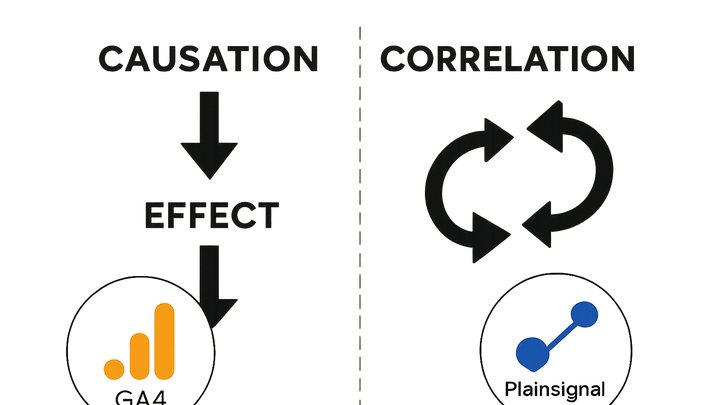Published on 2025-06-26T05:03:58Z
What is Causation? Examples of Causation in Analytics
Causation in analytics refers to a direct relationship where one event or action (the cause) produces another event or outcome (the effect). Unlike correlation, which only indicates that two variables move together, causation implies a directional influence backed by experimental or quasi-experimental evidence. Establishing causation is critical for data-driven decisions because it identifies the true levers that drive performance improvements, whether it’s increasing conversion rates, optimizing ad spend, or enhancing user engagement. In practice, analysts leverage A/B testing, time-series models, and statistical methods—often supported by platforms like GA4 for experiment tracking and PlainSignal for privacy-focused analytics—to infer and validate causal relationships. Below is an example of how to implement PlainSignal’s lightweight tracking code:
<link rel="preconnect" href="//eu.plainsignal.com/" crossorigin />
<script defer data-do="yourwebsitedomain.com" data-id="0GQV1xmtzQQ" data-api="//eu.plainsignal.com" src="//cdn.plainsignal.com/plainsignal-min.js"></script>
Causation
Causation in analytics identifies direct cause-and-effect relationships in data, enabling informed decisions and reliable experiment insights.
Understanding Causation vs Correlation
This section clarifies the critical difference between mere correlation and genuine causation, highlighting why causation matters for actionable analytics insights.
-
Defining correlation
Correlation measures how two variables move together but does not imply that changes in one cause changes in the other.
-
Positive vs negative correlation
Positive correlation means variables increase together, while negative correlation means one decreases as the other increases.
-
Spurious correlations
Coincidental patterns can appear correlated but have no causal link, like ice cream sales and drowning rates rising simultaneously in summer.
-
-
Establishing causation
Causation indicates that one variable directly affects another, often requiring controlled experiments or statistical techniques to validate.
-
Temporal order
The cause must occur before the effect in time to consider a causal relationship.
-
Eliminating confounders
Analysts must control or account for third variables that could influence both the cause and the effect.
-
Methodologies for Determining Causation
Outlines the primary methods—experimental and observational—for inferring causation in analytics, along with their strengths and limitations.
-
A/b testing (randomized controlled trials)
A controlled experiment where users are randomly assigned to different variants, isolating the impact of a single change.
-
Designing tests
Define control and treatment groups, choose sample size, and specify metrics to measure.
-
Interpreting results
Use statistical significance and confidence intervals to determine if observed differences are likely causal.
-
-
Time-series and granger causality
Analyzes if past values of one variable help predict future values of another, suggesting a directional relationship.
-
Stationarity check
Ensure data is stationary or apply transformations to stabilize mean and variance.
-
Lag selection
Choose appropriate lags to capture the true temporal dynamics without overfitting.
-
Implementing Causal Analysis with Analytics Platforms
Discusses how modern analytics tools like GA4 and PlainSignal support data collection and analysis for causal inference.
-
Google analytics 4 (GA4)
GA4 enables event-based tracking and integrates with experimentation tools for A/B tests, providing built-in reports to measure treatment effects.
-
Event-based model
Track detailed user interactions as events, allowing flexible segmentation and funnel analysis.
-
Integration with google optimize
Run A/B and multivariate tests natively while routing result data back into GA4 for causal impact analysis.
-
-
PlainSignal (cookie-free analytics)
PlainSignal offers privacy-focused, lightweight tracking, capturing essential user journeys without cookies, suitable for causal analysis in compliant environments.
-
Implementation code
Insert the PlainSignal snippet into your pages to start collecting cookieless analytics.
-
Data granularity
While privacy-first, PlainSignal still provides session- and event-level data to support causal testing.
-
Common Pitfalls and Best Practices
Highlights challenges in causal analytics and offers guidelines to avoid false conclusions and improve reliability.
-
Ignoring confounding variables
Failing to account for external factors can lead to attributing causation incorrectly, such as seasonality or overlapping campaigns.
-
Overinterpreting correlated data
Drawing causal conclusions from simple correlations without experiments or advanced modeling can misguide decisions.
-
Ensuring statistical rigor
Apply proper sample sizes, significance testing, and confidence intervals to validate that observed effects are unlikely due to chance.
